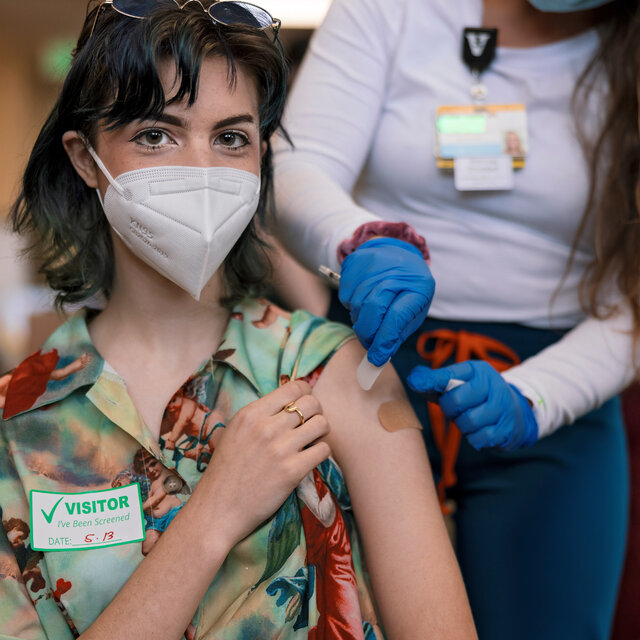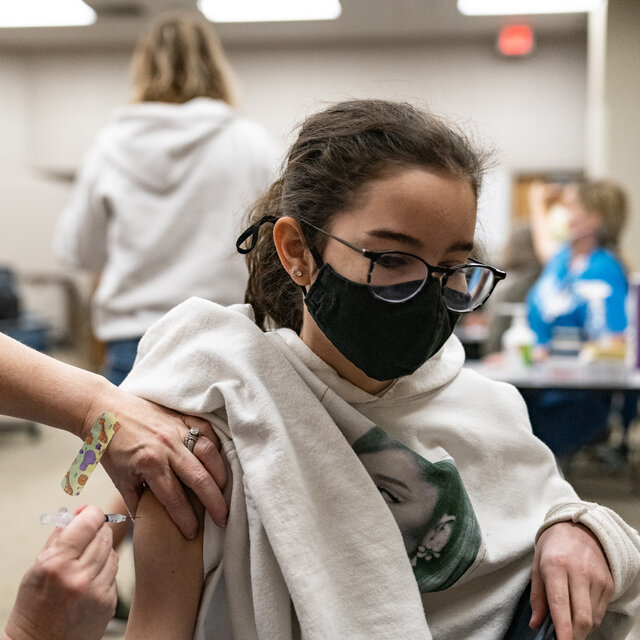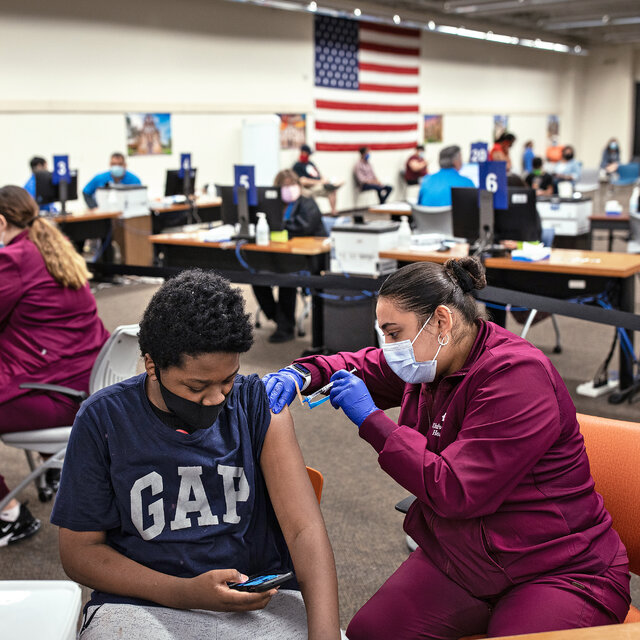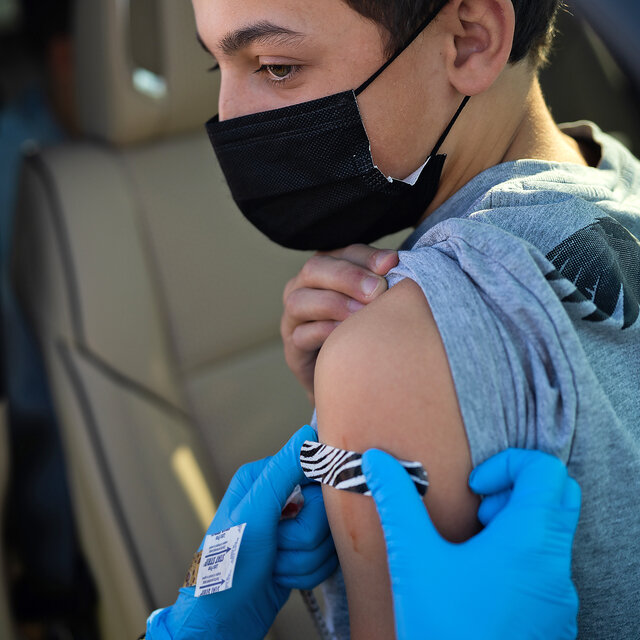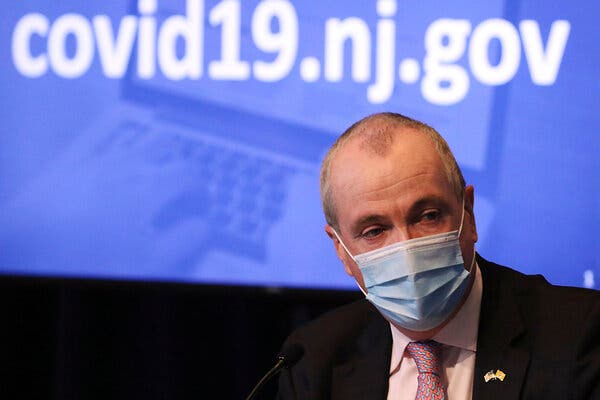
As federal health officials on Thursday cleared the way for Americans who are fully vaccinated against the coronavirus to drop mask wearing in most situations, some states lifted mask mandates, while others took a more cautious approach.
“We have all longed for this moment,” Dr. Rochelle P. Walensky, the C.D.C. director, said at a White House news conference on Thursday. “If you are fully vaccinated, you can start doing the things that you had stopped doing because of the pandemic.”
Most of the state officials who responded to the shift were Democrats. Half of the country’s governors — most of them Republicans — had already lifted mask mandates in some form.
On Thursday, the governors of Massachusetts, New York, New Jersey, North Carolina, and Virginia, and the mayors of New York City and Washington, D.C., all Democrats, said they were taking the new guidance from the Centers for Disease Control and Prevention under advisement before adopting it. In deference to local authorities, the C.D.C. said vaccinated people must continue to abide by existing state, local, or tribal laws and regulations, and follow local rules for businesses and workplaces.
Gov. Andrew Cuomo of New York said that the state had “always relied on the facts and the science to guide us throughout the worst of this pandemic” and that he would review the new federal guidelines with the state Health Department and health experts in neighboring states. Mayor Bill de Blasio of New York City called the shift in guidance “a monumental day in the fight against Covid” but said the city would be reviewing the new rules “as masks will still be important for schools, public transportation, doctors offices and more.”
“The message is clear,” he added. “Vaccinations are the way to bring our city, our lives, back.”
In North Carolina, a spokeswoman for Gov. Roy Cooper echoed that idea, but said that an indoor mask mandate would remain in effect while state health officials reviewed the recommendations.
The Los Angeles County Department of Public Health said “the county and the state will review the recommendations in order to make sensible adjustments.” On Wednesday, Gov. Gavin Newsom said the state would eliminate its outdoor mask mandates on June 15, when the state plans to fully reopen.
After the C.D.C.’s new guidance was announced, at least seven states led by Democrats began to lift mask mandates. Connecticut, Illinois, Kentucky, Minnesota, Nevada, Oregon, and Pennsylvania began to adjust their mask wearing guidance.
Gov. Andy Beshear of Kentucky,called the C.D.C.’s announcement the “news that we have all been waiting for.”
In a recorded video, Mr. Beshear said there were “hundreds of thousands” of available vaccine appointments and encouraged all state residents to take advantage of them. “If you get vaccinated, the C.D.C. says it is safe to take that mask off.”
In Washington State, Gov. Jay Inslee, who usually wears a mask while speaking at his news conferences, began his gathering on Thursday by removing it. He said the state was immediately incorporating the new federal guidance on mask wearing.
“This is a heck of a benefit for people who have been annoyed by this mask,” Mr. Inslee said. “This is a really good reason to get vaccinated. That shot is a ticket to freedom from masks.”
The new policy seemed to catch many retailers and their workers by surprise. Macy’s, Target and the Gap said they were still reviewing the new guidance, while Home Depot said it had no plans to change its current rules requiring customers and workers to wear masks in its stores.
The United Food and Commercial Workers union, representing thousands of grocery store workers, criticized the C.D.C. for failing to consider how the new policy would impact workers who have to deal with customers who are not vaccinated. “Millions of Americans are doing the right thing and getting vaccinated, but essential workers are still forced to play mask police for shoppers who are unvaccinated and refuse to follow local Covid safety measures,” the union’s president, Marc Perrone, said in a statement. “Are they now supposed to become the vaccination police?”
The Retail Leaders Industry Association, a trade group, said that the policy complicated matters in states that still have mask mandates in place that retailers must follow. “These conflicting positions put retailers and their employees in incredibly difficult situations,” the group said in a statement.
The new advice — that Americans who are fully vaccinated against the virus may stop wearing masks or maintaining social distance in most indoor and outdoor settings, regardless of size — was a sharp turnabout for federal health officials. It also comes with caveats. Even vaccinated individuals must cover their faces and physically distance when going to doctors, hospitals or long-term care facilities like nursing homes; when traveling by bus, plane, train or other modes of public transportation, or while in transportation hubs like airports and bus stations; and in congregate settings such as homeless shelters, as well as prisons or jails.
At a White House news conference on Thursday, Dr. Rochelle P. Walensky, the C.D.C. director, warned that unexpected twists in the pandemic could require the agency to again amend the guidance.
She defended the timing of the new mask guidance, pointing to a steep drop in coronavirus cases, which have dropped by about a third in the last two weeks, and a sustained increase in supply of vaccines.
Some fully vaccinated people have been infected with the coronavirus. Dr. Walensky said that any who develop symptoms should still use masks and get tested, she said. Asked how the new guidance might apply to businesses and schools, she said that the C.D.C. was working to rapidly issue new recommendations soon for specific settings, including for summer camps and travel.
The move could raise alarms among more cautious Americans, who may be more reluctant to engage in public activities when more people are unmasked. There is no way to know who is vaccinated and who is not, and the majority of the population is not yet fully vaccinated. Dr. Walensky added that immunocompromised people who have been fully vaccinated should consult their physicians before relinquishing a face mask.
Still, the changes are likely to galvanize Americans who have become unaccustomed to appearing in public unmasked — or to seeing others do so.
Michael Corkery, Sapna Maheshwari Lauren Hirsch and Mike Baker contributed reporting.
transcript
transcript
C.D.C. Relaxes Mask Guidance for Vaccinated People
On Thursday, Dr. Rochelle P. Walensky, the Director of the Centers for Disease Control and Prevention said that Americans who are fully vaccinated no longer need to wear masks in most indoor or outdoor settings.
-
“Today, C.D.C. is updating our guidance for fully vaccinated people. Anyone who is fully vaccinated can participate in indoor and outdoor activities, large or small, without wearing a mask or physical distancing. If you are fully vaccinated, you can start doing the things that you had stopped doing because of the pandemic. We have all longed for this moment when we can get back to some sense of normalcy. Based on the continuing downward trajectory of cases, the scientific data on the performance of our vaccines and our understanding of how the virus spreads, that moment has come for those who are fully vaccinated.” “Almost 200 million people having been vaccinated here in the United States and worldwide. I mean, we’ve administered 264 million doses in the United States. The safety profile is really quite firm and sound.”
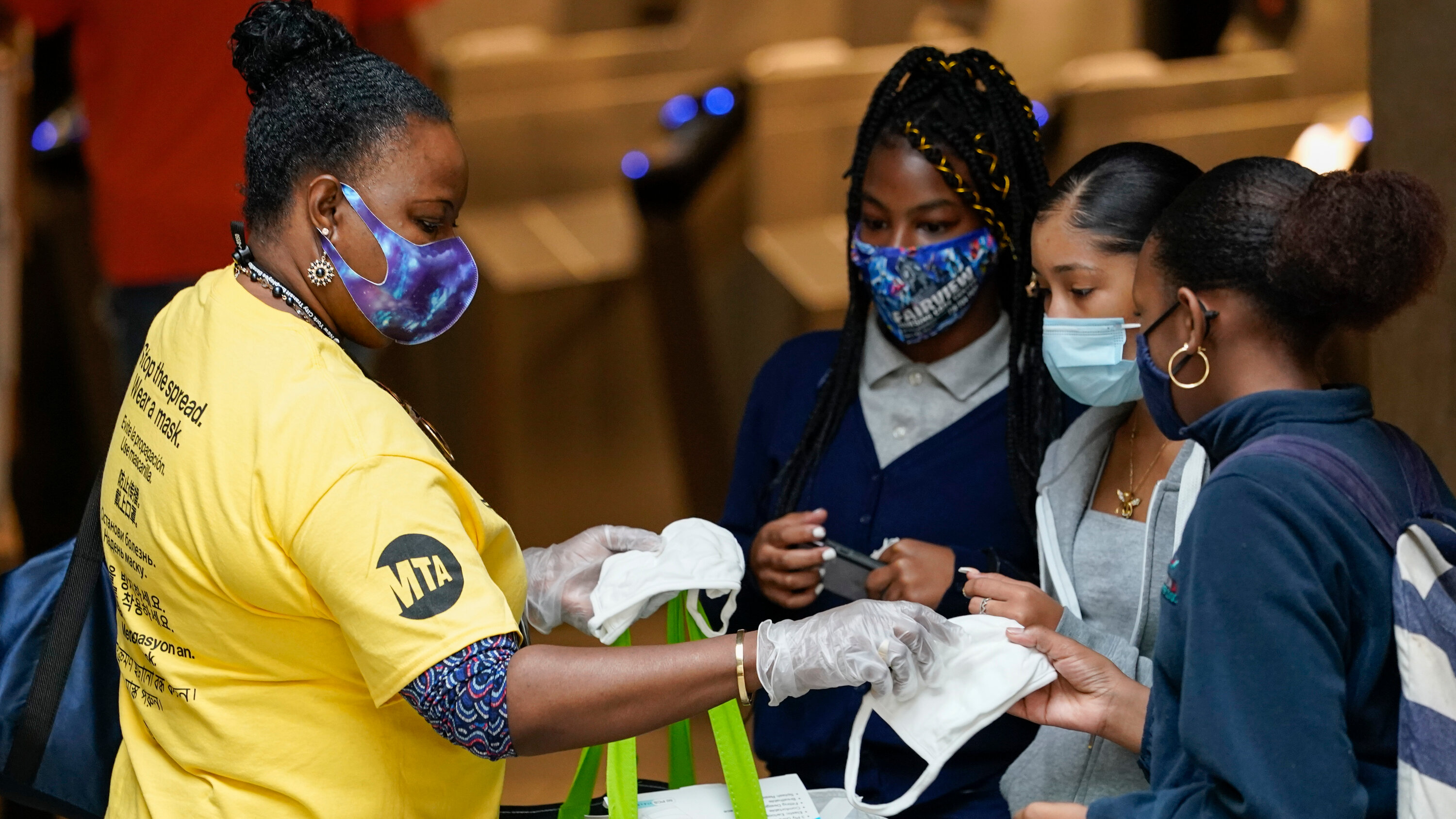
Federal health officials on Thursday advised Americans who are fully vaccinated against the coronavirus that they could stop wearing masks or maintaining social distance in most settings, the clearest sign yet that the pandemic might be nearing an end in the United States.
The new recommendations from the Centers for Disease Control and Prevention caught state officials and businesses by surprise and raised a host of difficult questions about how the guidelines would be carried out. But the advice came as welcome news to many Americans who were weary of restrictions and traumatized by the past year.
“We have all longed for this moment,” Dr. Rochelle P. Walensky, the C.D.C. director, said at a White House news conference on Thursday. “If you are fully vaccinated, you can start doing the things that you had stopped doing because of the pandemic.”
Masks had come to symbolize a bitter partisan divide. Setting them aside in restaurants and sidewalks, in museums and shops, would represent not just the beginning of the end of the pandemic but hope for a return to normalcy.
Permission to stop using masks also offers an incentive to the many millions who are still holding out on vaccination. As of Wednesday, about 155 million people had received at least one dose of a Covid-19 vaccine, but only about one-third of the nation, 119 million people, had been fully vaccinated.
And the pace of vaccination has slowed: Providers are administering about 2.09 million doses per day on average, about a 38 percent decrease from the peak of 3.38 million reported in mid-April.
transcript
transcript
Biden Celebrates New C.D.C. Mask Guidance
President Biden applauded new guidance from the Centers for Disease Control and Prevention that allows Americans who are fully vaccinated to stop wearing masks for most indoor and outdoor gatherings.
-
Just a few hours ago, the Centers for Disease Control and Prevention, the C.D.C., announced that they are no longer recommending that fully vaccinated people need wear masks. This recommendation holds true, whether you are inside or outside. I think it’s a great milestone, a great day. It’s been made possible by the extraordinary success we’ve had in vaccinating so many Americans so quickly. The C.D.C. is saying they have concluded that fully vaccinated people are at a very, very low risk of getting Covid-19. Therefore, if you’ve been fully vaccinated, you no longer need to wear a mask. But if you’ve not been vaccinated or if you’re getting a two-shot vaccine and you’ve not gotten your, you only had your first shot, but not your second, or you haven’t waited the full two weeks after your second shot, you still need to wear a mask. Look, we’ve gotten this far. Please protect yourself.

At the White House on Thursday, President Biden hailed the new recommendations as a “milestone” in the nation’s effort to beat back the pandemic and urged Americans to roll up their sleeves for vaccinations.
While there may well be scientific justification for the guidelines, they raised a host of questions for which there are no easy answers: How to trust that unvaccinated neighbors will wear masks when they should? What about younger children, for whom no vaccinations have been authorized, and schools? Is it possible to enforce such guidelines?
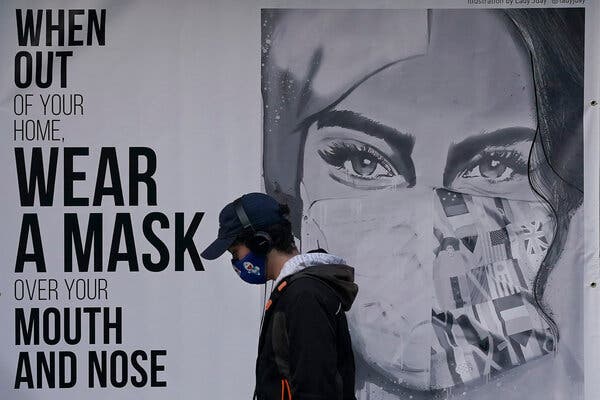
When federal health officials said on Thursday that fully vaccinated Americans no longer needed to wear masks in most places, it came as a surprise to many people in public health. It also was a stark contrast with the views of a large majority of epidemiologists surveyed in the last two weeks by The New York Times.
In the informal survey, 80 percent said they thought Americans would need to wear masks in public indoor places for at least another year. Just 5 percent said people would be able to stop wearing masks indoors by this summer.
In large crowds outdoors, like at a concert or protest, 88 percent of the epidemiologists said it was necessary even for fully vaccinated people to wear masks.
“Unless the vaccination rates increase to 80 or 90 percent over the next few months, we should wear masks in large public indoor settings,” said Vivian Towe, a program officer at the Patient-Centered Outcomes Research Institute.

CHARLESTON, W.Va. — Jill Biden, the first lady, landed in West Virginia just as the Centers for Disease Control and Prevention said on Thursday that vaccinated Americans could, for the most part, remove their masks. So, just before she disembarked from her plane, she did.
After weeks of murky guidance from the C.D.C. on what vaccinated Americans can and can’t do, the sight of a maskless first lady went far to clear up confusion — at least in Charleston, where she visited a vaccine clinic for children set up inside a local high school.
“We feel naked!” Dr. Biden said to a group of junior Army officers who had gathered to greet her. “I didn’t mean it that way.”
It was a surreal and memorable moment that underscored in a very public way just how strange these past million or so months have been. Back in Washington, officials in the Biden White House (quite literally) were able to breathe freely again as, one by one, masks began to come off.
At the White House, a maskless President Biden struck a more statesmanlike tone when he addressed the public in the Rose Garden.
“The Centers for Disease Control and Prevention and C.D.C. announced that they’re no longer recommending that fully vaccinated people need wear masks,” Mr. Biden said. “This recommendation holds true whether you are inside or outside. I think it’s a great milestone, a great day.”
At an earlier meeting on infrastructure, held in the Oval Office with a bipartisan group of senators, Mr. Biden — whose advisers were so strict about masks that they were known to police private meetings — stripped off his face covering, and so did the senators, Senator Shelley Moore Capito of West Virginia told reporters.
In the West Wing, officials, who have refrained from holding large in-person meetings together, began removing their masks as the administration issued new guidance for anyone on the complex: Anyone who had received their last required vaccine dose at least 14 days earlier could now go mask-free.
Elsewhere in the capital, other lawmakers celebrated the new guidance.
Senator Mitch McConnell, Republican of Kentucky and the minority leader, quoted the Rev. Dr. Martin Luther King Jr. to reporters as he addressed them without a mask for the first time in months: “Free at last.”
In the House of Representatives, the Capitol’s attending physician issued an updated guidance for lawmakers and their staff that said those who were fully vaccinated could “resume activities that you did prior to the pandemic” more or less as normal inside House office buildings. But the physician, Dr. Brian P. Monahan, said face coverings would still be required around the House floor.
“For the Hall of the House: The present mask requirement and other guidelines remain unchanged until all members and floor staff are fully vaccinated,” he wrote in a memo circulated to House offices.
On the road in Charleston, Dr. Biden, accompanied by Senator Joe Manchin III, Democrat of West Virginia, did their part to motivate the public.
“You’ve all seen the latest from the C.D.C.? That means no masks inside or outside,” Mr. Manchin said to a group of reporters.
“What does that mean for the people of West Virginia?” a reporter asked.
“It means get vaccinated!” Mr. Manchin said. “We feel free.”
It didn’t hurt their cause that the actress Jennifer Garner, who grew up in the state, appeared alongside them for the visit.
transcript
transcript
U.S. Begins Vaccine Rollout for Children Ages 12 to 15
Children across the country began receiving the coronavirus vaccine on Thursday, after the federal government recommended making the Pfizer-BioNTech vaccine available to those aged 12 to 15. The U.S. is the first in the world to launch a mass vaccination campaign for children.
-
“Sidney is a 13-year-old, she’s in the eighth grade at Our Lady of Perpetual Help. She’s an excellent dancer, painter.” “Great. Are you ready?” “Uh huh.” “One, two three. All done, all right?” “Brendan is 13. He attends Great Neck South Middle School. He’s an amazing trumpet player.” “All right, are you ready? OK, one, two three. You’re done. OK, all done, all over.” “Congratulations.” [applause]
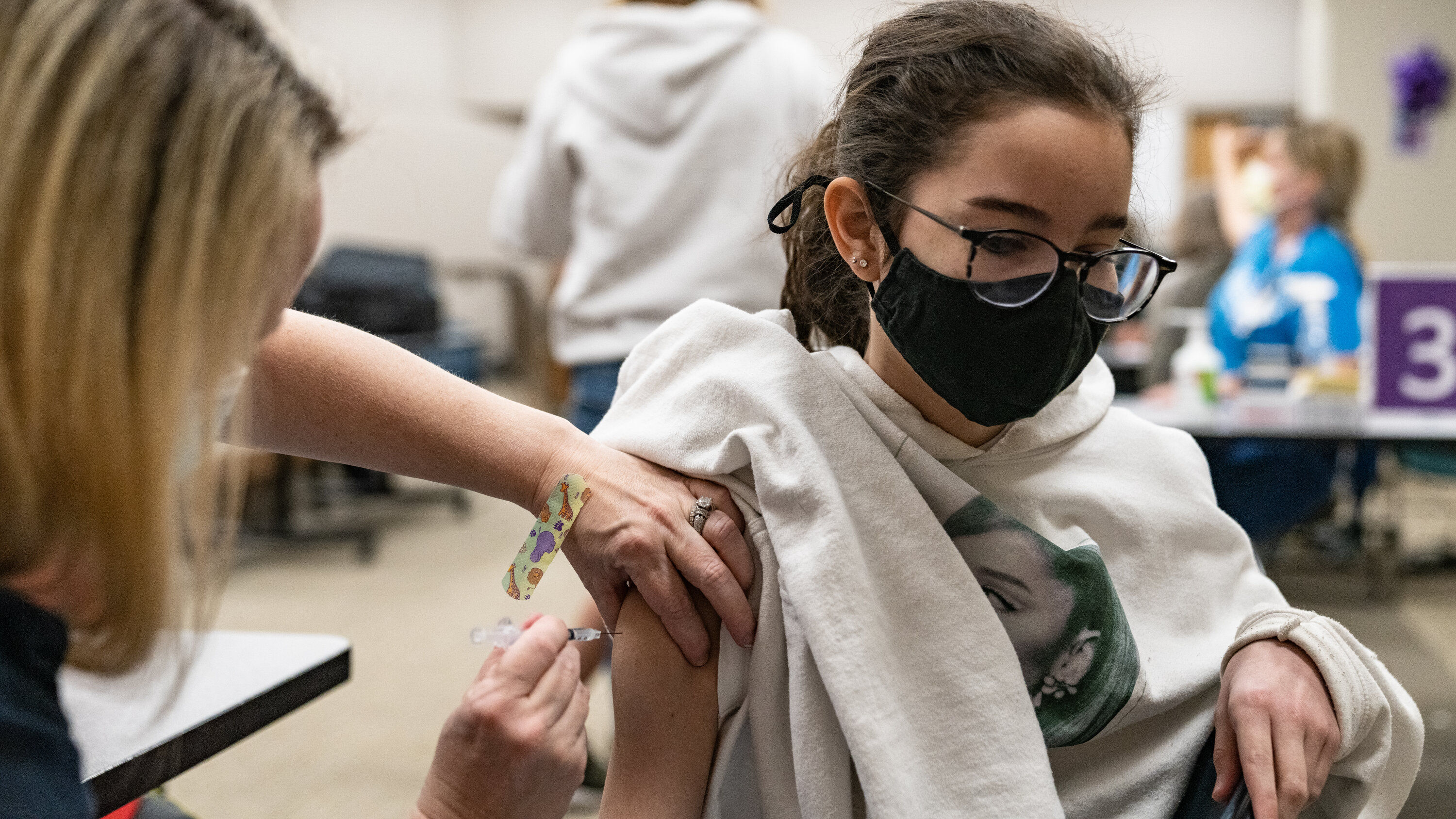
Eduardo Torres, 53, was up early in Chicago on Thursday morning when he heard the news on the television: Younger adolescents, including his 14-year-old daughter, Raquel, were now eligible for the coronavirus vaccine.
“I told my wife, ‘I’ve got to take her to get vaccinated — immediately,’” he said.
The world’s first mass coronavirus inoculation campaign for children kicked off in earnest in the United States on Thursday after the federal government recommended making the Pfizer-BioNTech vaccine available to those aged 12 to 15. Vaccinations of adolescents had already begun this week in a few states, like Maine.
There are about 17 million children between the ages of 12 and 15 in the United States, representing about 5 percent of the population. The changes — which mean that people ages 12 and up are now eligible — also opened the possibility that many more children may soon return to a semblance of normalcy, attending camps this summer and returning to in-person school by fall.
By 9:30 a.m., Raquel was among the first wave of children in her age group to be vaccinated at a site near Wrigley Field and was excitedly listing the things she could do once she is fully vaccinated. Go to her high school in person again. See her friends without worrying. Return to playing volleyball and bowling.
“It’s just a beautiful thing that this is available,” Mr. Torres said.
Mayor Bill de Blasio encouraged parents to have their children vaccinated to protect their families. “Parents, let’s get our zoomers off of Zoom and back to life as normal,” he said Thursday morning.
To encourage more New Yorkers to get shots, the mayor announced that people who’ve been vaccinated can win tickets for two outdoor music festivals, the Governors Ball at Citi Field and Global Citizen Live in Central Park.
The Shake Shack restaurant chain said it would give vouchers good for a free hamburger or sandwich to people who are vaccinated at a city mobile clinic. And for the next month, it said, customers who show a vaccination cards can get a free side order of french fries.
Amanda Rosa contributed reporting.
Before they can resume indoor restaurant meals, parties and sleepovers with their friends, younger teenagers have been stopping at the mall. That’s where many were on Thursday, lining up not for the latest fashion fad or video game, but to become among the first children aged 12 to 15 to get the Pfizer-BioNTech vaccine, newly authorized for them by the federal government on Wednesday.
At a mall in San Antonio, Haley Cruz, 13, stood quietly in line with her parents until a nurse called her over. She sat still in an orange chair and winced behind a black mask when a nurse jabbed a needle on her left arm.
“It didn’t hurt, just a little pinch,” Haley said. “I feel better now.”
The night before, her mother, Regina Beltran, 47, had mentioned casually that instead of signing on for remote learning Thursday morning, they would be going to the Wonderland of the Americas mall, known for its display of flags of countries from around the world. Before Haley got too excited, though, Ms. Beltran explained that the trip was to get the vaccine.
“I now feel she is more protected — I was worried,” Ms. Beltran said, adding that the Cruz family had known at least 10 people who died from Covid-19. “Thank God she qualified. I don’t want to lose any more people.”
Officials in 49 states confirmed on Thursday that they were now offering the vaccine to people age 12 and up. State officials in Montana did not provide information, but county officials in parts of the state said they were offering shots to children in that age group.
Bigger crowds were expected at malls after the school day was over. And the atmosphere was similar at other vaccination sites.
At a Vanderbilt Health site in Nashville, a steady stream of children and their parents moved through the line during the day, beginning at 8 a.m. Open appointments for the day were filled within a few hours of being posted on Wednesday, said Heather O’Dell, who is overseeing Vanderbilt’s vaccine site operations. She expected 750 patients, mostly adolescents, on Thursday and was seeing weekend openings fill up as well.
“It’s almost like a social hour,” Ms. O’Dell said. “Kids are seeing other kids they go to school with. Parents are seeing other parents they haven’t seen in a while.”
For Calysta Magne-Gordon, 13, and her father, Cyrille Magne, there was no doubt about whether she would get the vaccine, only a question of how soon she would be eligible. She wanted the shot “as fast as possible,” she said.
“I was like, ‘Do it,’” Calysta said, snapping her fingers. “I don’t care how early I have to wake up in the morning, I need to get that vaccine.”
She has spent eighth grade in an online classroom. But now that she is getting vaccinated, she will be able to attend — in person — an overnight art and music camp in Michigan.
“I have a lot of friends who don’t live here,” she said. “If I am able to see them, that would be great. I can go see family out of state. There are so many social possibilities opened up. I can see so many people. I don’t have to worry about getting sick or potentially affecting family members.”
At a city-run vaccination site next to Wrigley Field in Chicago, families with teenagers were among the first to arrive on Thursday, stopping off for a shot before school or work.
Charlotte O’Halloran, 13, emerged with her father, Brian. She was the last member of their household to be vaccinated, following both parents and three older siblings.
“I’ll be able to go out more,” she said. “I can worry a little bit less.”
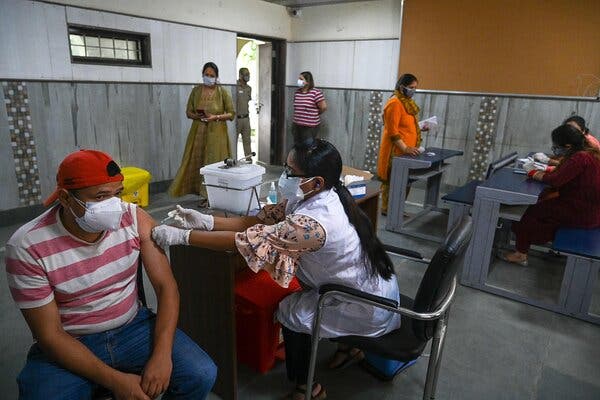
With new infections now engulfing rural regions across India even as the daily death toll in crowded cities remains staggeringly high, regional leaders across the country are engaged in a desperate struggle to secure vaccines and stretch the doses they have on hand.
The states of Maharashtra and Karnataka, where case numbers are surging, have suspended vaccination altogether for people under 45 so that older people can receive second doses.
And a government panel on Thursday recommended widening the gap — for the third time since March — between the first and second doses of the Oxford-AstraZeneca vaccine, also known as Covishield in India.
Prime Minister Narendra Modi of India is facing increasing pressure to quickly expand the scope of the country’s fledging Covid-19 vaccination campaign as major cities run out of doses.
Some states and cities have started floating their own global tenders to import vaccines.
In a rare show of unity, a dozen opposition parties called for free, universal vaccination in a letter that said the pandemic had “assumed unprecedented dimensions of a human catastrophe.”
The parties also said that Mr. Modi’s government should invoke an order temporarily suspending patent protections for vaccines — a proposal India and South Africa jointly made for all virus vaccines globally that is under consideration by the World Trade Organization. In India, the order would allow more factories to make Covaxin, the indigenous vaccine codeveloped by the Indian government’s top scientific research body and the Hyderabad-based company Bharat Biotech.
Covaxin is in such short supply that the capital, New Delhi, has had to shutter about 100 vaccination centers. All of the doses produced by the Serum Institute of India, which is producing the Oxford-AstraZeneca shots and is the world’s largest vaccine maker, are staying in India, but still falling far short of the requirements for a population of nearly 1.4 billion people.
The ad hoc approach could also further fuel the skepticism and hesitancy that greeted the rollout of shots this winter. Leaders of Mr. Modi’s Bharatiya Janata Party claimed that the virus had been all but defeated in India, possibly tempering interest in a vaccine.
Jairam Ramesh, leader of the opposition Indian National Congress party, questioned the validity of widening the intervals between doses.
“Is this because there are not enough stocks of the vaccines for all who are eligible or because professional scientific advice says so?” Mr. Ramesh wrote on Twitter.
India reported about 362,000 cases on Wednesday, with infection numbers appearing to level off in Delhi and in the financial capital, Mumbai, but picking up in the southern city of Bengaluru and across rural India.
Less than 3 percent of the population has been fully vaccinated.
Lockdown restrictions are in place in many parts of India, but on Thursday, when Muslims celebrated Eid al-Fitr, the end of the fasting month of Ramadan, people were seen crowding markets.
The Pfizer-BioNTech and Moderna coronavirus vaccines are safe and effective during pregnancy, according to preliminary results from two continuing studies.
Both vaccines produce robust immune responses in pregnant and lactating women, and are likely to provide at least some protection against two dangerous coronavirus variants, B.1.1.7 and B.1.351, according to a study published in JAMA on Thursday. Vaccinated women can also pass protective antibodies to their fetuses through the bloodstream and to their infants through breast milk, the research suggests.
In a second study, published in the journal Obstetrics & Gynecology on Tuesday, researchers found no evidence that either the Pfizer or Moderna vaccines damaged the placenta during pregnancy.
Covid presents serious risks during pregnancy. Research has shown that pregnant women with coronavirus symptoms are more likely to be admitted to the intensive care unit, to require mechanical ventilation and to die from the virus than are symptomatic women of a similar age who are not pregnant.
Because of these risks, the Centers for Disease Control and Prevention has recommended that the vaccines at least be made available to pregnant people, many of whom have opted to receive the shots.
“We can shift our framework from, ‘Let’s protect pregnant people from the vaccine,’ to ‘Let’s protect pregnant people and their infants through the vaccine,’” said Dr. Emily S. Miller, an expert in maternal-fetal medicine at Northwestern University and co-author of the placenta study. “I think that’s really powerful.”
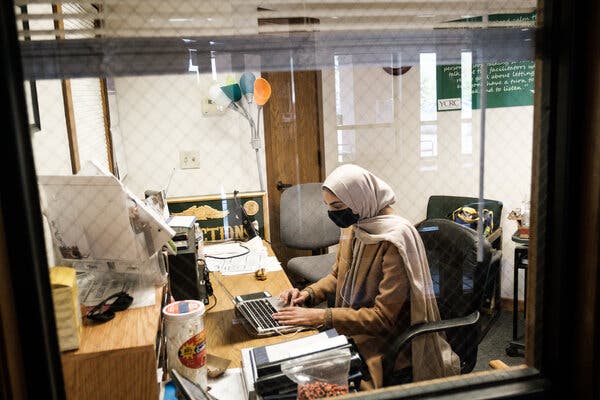
The Biden administration on Thursday outlined how it will spend $7 billion to expand the nation’s public health workforce, adding tens of thousands of jobs to respond to the Covid-19 pandemic and future outbreaks, including disease investigators, contact tracers and epidemiologists.
Over $4 billion will go to state and local health departments to help with their Covid-19 response, the White House said in a news release, allowing them to “quickly add staff.” Hiring would include vaccine and test administrators, data scientists, epidemiologists and school nurses who can work to vaccinate teens and children in the coming months. Some of the hiring will boost the ranks at the Epidemic Intelligence Service, the vaunted arm of the Centers for Disease Control and Prevention that investigates disease outbreaks.
“Though many threats have increased in complexity and scale in recent years, our nation’s public health workforce has gotten smaller,” Dr. Rochelle Walensky, the C.D.C. director, said at a White House news conference Thursday. “This support will immediately add more staff in health departments across the country.”
C.D.C. leaders have long complained of neglect and underfunding, saying that lawmakers typically only send more resources to the agency when there is a dire public health emergency. Other federal health agencies, particularly the National Institutes of Health, are significantly better funded. Many local health departments have also been short on funding for years.
State and local governments would be able to decide how they use the money, which was allocated through the American Rescue Plan, said Carole Johnson, the Biden administration’s testing coordinator.
The funding underscored a sharp contrast with the Trump administration, which routinely sought to cut off congressional funding for the C.D.C. and stifle its independence within the Department of Health and Human Services.
And it offered relief for local health departments that have been sapped by low morale, firings and harassment. One challenge, though, might be finding enough qualified people to fill new job openings.
Ms. Johnson said money could also go to increasing the number of “disease intervention specialists,” or health workers who would conduct contact tracing, work on case management and help with outbreak investigations. And $400 million would go to a new partnership between the C.D.C. and AmeriCorps, a sprawling national service organization. Called Public Health AmeriCorps, the program would form a “pipeline” for public health workers.
The administration was providing another $3 billion to a new C.D.C. grant program to help smaller local health departments keep staff. The grants would allow those hired to help with the coronavirus pandemic to “continue their careers beyond the pandemic as public health professionals,” the White House said.
“We really are asking grantees to prioritize recruiting from communities they serve and backgrounds that are underrepresented,” Ms. Johnson said.
A group of 18 scientists stated Thursday in a letter published in the journal Science that there is not enough evidence to decide whether a natural origin or an accidental laboratory leak caused the Covid-19 pandemic.
They argued, as the U.S. government and other countries have, for a new investigation to explore where the virus came from.
The organizers of the letter, Jesse Bloom, who studies the evolution of viruses at the Fred Hutchinson Cancer Research Center in Seattle, and David Relman, a microbiologist at Stanford University, said they strove to articulate a wait-and-see viewpoint that they believe is shared by many scientists. Many of the signers have not spoken out before.
“Most of the discussion you hear about SARS-CoV-2 origins at this point is coming from, I think, the relatively small number of people who feel very certain about their views,” Dr. Bloom said.
He added: “Anybody who’s making statements with a high level of certainty about this is just outstripping what’s possible to do with the available evidence.”
The new letter stated: “Theories of accidental release from a lab and zoonotic spillover both remain viable.”
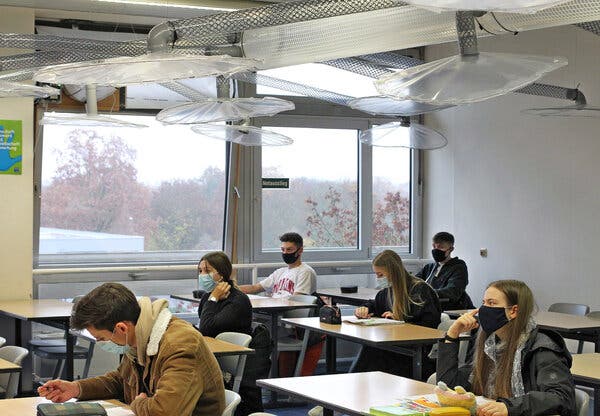
A leading group of scientists urged governments and engineers to improve air quality in the workplace in the wake of the Covid-19 pandemic, drawing a parallel to movements that led to cleaner water, food safety rules and a ban on lead-based paint.
Sweeping public health reforms transformed not just our environment but expectations for what governments can do, according to a group of 39 scientists that published a manifesto of sorts on Thursday in the journal Science. They called for a “paradigm shift” in how citizens and government officials think about the quality of the air we breathe indoors.
The timing of the scientists’ call to action coincides with the nation’s large-scale reopening as coronavirus cases steeply decline: Americans are anxiously facing a return to offices, schools, restaurants and theaters — exactly the type of crowded indoor spaces in which the coronavirus is thought to thrive.
There is little doubt now that the coronavirus can linger in the air indoors, floating far beyond the recommended six feet of distance, the experts declared. The accumulating research puts the onus on policymakers and building engineers to provide clean air in public buildings and to minimize the risk of respiratory infections, they said.
“We expect to have clean water from the taps,” said Lidia Morawska, the group’s leader and an aerosol physicist at Queensland University of Technology in Australia. “We expect to have clean, safe food when we buy it in the supermarket. In the same way, we should expect clean air in our buildings and any shared spaces.”
Meeting the group’s recommendations would require new workplace standards for air quality, but the scientists maintained that the remedies do not have to be onerous. Air quality in buildings can be improved with a few simple fixes, they said: adding filters to existing ventilation systems, using portable air cleaners and ultraviolet lights — or even just opening the windows where possible.

While some states are offering residents incentives like savings bonds or sports tickets to encourage them to be vaccinated, a few are making a very different pitch: The sooner you get a shot, the sooner the state will fully reopen.
The latest is Oregon, where the governor said on Tuesday that the state’s remaining restrictions would stay in place until at least 70 percent of eligible residents 16 and older had had at least one shot.
“We still have some work to do to reach our 70 percent goal, but I am confident we can get there in June and return Oregon to a sense of normalcy,” said Gov. Kate Brown, a Democrat.
Oregon, where 49 percent of residents have had at least one dose, is one of the few states that is explicitly tying lifting its indoor mask requirement to the adult vaccination rate. Michigan, Minnesota and Pennsylvania also are awaiting the 70 percent threshold before moving forward with reopening plans.
In Michigan, capacity limits for businesses will lift two weeks after 65 percent of eligible residents have been vaccinated, and the gatherings and face mask orders will end two weeks after 70 percent of eligible residents have been fully vaccinated, Gov. Gretchen Whitmer said. Thirty-seven percent of residents there have been immunized in the state, which has shown one of the country’s steepest drops in cases over the past two weeks. The average number of new infections reported daily during that time sank 45 percent and hospitalizations were down 32 percent.
Pennsylvania is waiting for 70 percents of adults to be fully vaccinated before lifting its mask mandate. Only 37 percent have been immunized in Pennsylvania.
The mask requirement in Minnesota will be lifted once 70 percent of residents 16 and older have received at least one dose of a Covid-19 vaccine, but no later than July 1, Gov. Tim Walz said. Half of Minnesotans have had at least one dose.
On Wednesday, Maryland said that every business would be allowed to open, starting on Saturday, at 100 percent capacity, but that the indoor mask requirement would be in place until 70 percent of adults had received one dose. So far, only 52 percent have met that guideline.
“Those who are not vaccinated continue to slow our health and economic recovery efforts, and they also continue to be at risk for infection, hospitalization and death,” Gov. Larry Hogan said on Wednesday.
In New Jersey, Gov. Phil Murphy said on Wednesday that he would be signing an executive order that would put into effect what he called “our most aggressive reopening play” to date. As was announced last week, on Wednesday, May 19, many restrictions on public gatherings will be dropped although social distancing measures will be in effect. In New Jersey, 42 percent of adults are fully vaccinated and 55 percent have received one shot.
And in New Mexico, the state will remove most restrictions once 60 percent of residents have been fully vaccinated. Forty-two percent of people have been inoculated there.
But these statewide vaccination targets are well below what experts now calculate the herd immunity threshold to be: at least 80 percent.
President Biden has called for 70 percent of adults to have at least one dose by July 4. Jeffrey Zients, Mr. Biden’s Covid response coordinator, said that the goal should be to achieve some sense of normality by hitting that target. Reaching 70 percent will create “a pattern of decreasing cases, hospitalizations and deaths and take us down to a sustainable low level,” he said this week.

Gov. Ron DeSantis of Florida said on Wednesday that he would pardon “any Floridian” who violated mask or social distancing mandates.
Mr. DeSantis, a Republican, made the announcement during an appearance on the Fox News program “Ingraham Angle,” just a day before the Centers for Disease Control and Prevention shifted its guidelines to allow vaccinated people to skip wearing masks in most places.
The show’s host, Laura Ingraham, first interviewed Mike and Jillian Carnevale, the owners of a Broward County gym, who said they had been arrested for violating a county mask mandate. Mr. DeSantis then said their case was “a total overreach.”
Widely seen as positioning himself as a 2024 Republican presidential nominee, Mr. DeSantis throughout the pandemic has criticized coronavirus restrictions and mandates.
Mr. Carnevale said he and Ms. Carnevale were arrested three times after violating Broward County’s mask mandate. Mr. Carnevale was charged with two second-degree misdemeanors and if convicted would face a 120-day jail sentence, and Ms. Carnevale was charged with one second-degree misdemeanor, facing 60 days in jail, said Cory Strolla, a lawyer representing the couple.
Last month, Mr. DeSantis issued an executive order prohibiting businesses from requiring patrons or customers to show vaccination documentation, or risk losing grants or contracts funded by the state. Norwegian Cruise Line, which is requiring all guests and crew members to be vaccinated, said it was considering skipping Florida ports over the order.
